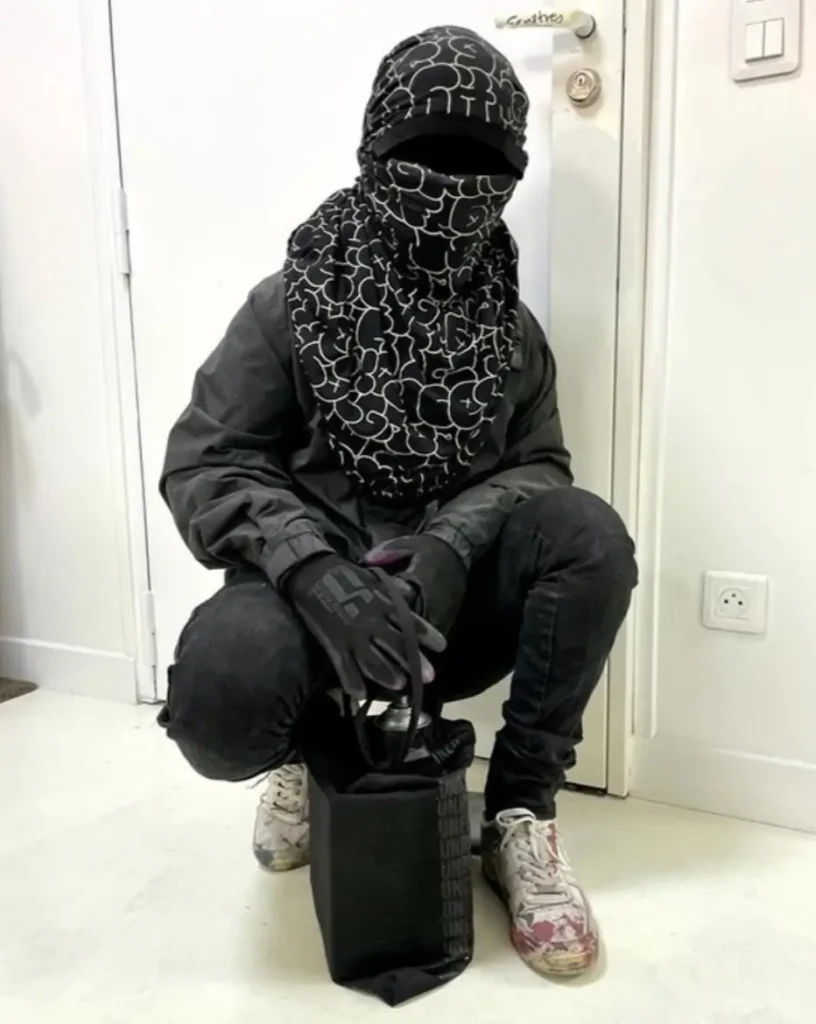In contemporary urban art, Nuno Viegas has carved an exceptional path from graffiti-covered walls in Portugal to the white-cube galleries of Europe. His 2018 sculptural assemblage Street Artist stands as both an homage and a self-portrait of the graffiti world he came from—a tribute to the anonymous makers who painted city walls under the cover of darkness, and a meditation on what happens when those same gestures migrate into fine art spaces.
Viegas’s work is quiet but loaded with cultural resonance: it speaks of anonymity and recognition, rebellion and respectability, impermanence and permanence. In Street Artist, those opposing forces meet in a single three-dimensional form, distilling a two-decade journey from street tagger to international artist.
plinths
Born in 1985 in Faro, Portugal, Nuno Viegas—also known by his graffiti moniker Metis—entered the art world through the subcultural door of tagging. The late-1990s graffiti movement along the Algarve coast inspired his earliest interventions: throw-ups on underpasses, quick silver outlines on rail walls, pieces created within tight time limits. In 1999, he founded the Policromia Crew, a collective that defined a generation of Portuguese street writers.
His formal education at the University of Algarve introduced a new dimension: painting, composition, and the critical frameworks of visual art. Yet he never abandoned graffiti’s codes—style, repetition, and anonymity. When he moved to Rotterdam in 2014, he began merging both languages: the visual cleanliness of studio work with the symbolic language of street culture.
By 2018, the year of Street Artist, this synthesis reached maturity. The sculpture manifests Viegas’s ongoing fascination with the dual identity of the graffiti writer—hidden and visible, outlaw and artist.
anatomy
The work itself measures roughly 130 × 50 × 50 cm and is described as an assemblage sculpture mounted on a metal pedestal. The form draws from Viegas’s familiar imagery: hooded figures, masks, gloves, and spray cans reinterpreted with refined clarity.
Though the sculpture’s full materials are undisclosed, the language of its surfaces suggests a combination of painted resin, metal, and textile—materials that echo the hybrid world between street and studio. The composition likely balances realism and stylisation: a partial body or object frozen mid-gesture, as though the act of painting has been translated into sculpture.
The pedestal isolates it as an art object, separating it from the environment that once defined graffiti’s existence. This act of elevation—the street practice placed on a plinth—summarises Viegas’s ongoing dialogue: between the spontaneous and the curated, the wall and the gallery.
material
For Viegas, materials are not neutral; they carry histories. The mask, glove, or spray can each embody a culture of resistance. In graffiti, anonymity is protection, a ritual, a badge of belonging. In the sculpture, that anonymity becomes emblematic—frozen, stylised, and permanent.
The transformation of these humble objects into art materials mirrors the artist’s own shift. What once belonged to the urban night is now part of the daylight economy of galleries and collectors. Viegas is acutely aware of this irony, and Street Artist feels both celebratory and conflicted: a monument to the scene that raised him, yet also a quiet critique of the systems that commodify rebellion.
Assemblage—the bringing together of disparate parts—is itself a metaphor for graffiti culture, which has always been about synthesis: mixing hip-hop, typography, architecture, and public space. The sculpture, then, becomes a kind of three-dimensional tag: a mark made in form rather than paint.
anonym
Viegas’s masked figures—often portrayed in his paintings holding spray cans, adjusting gloves, or hiding faces—capture the paradox of the graffiti writer: omnipresent yet unseen. In Street Artist, this theme deepens. The sculpted form, stripped of explicit identity, becomes every graffiti writer. It is the archetype of the urban artist—one who erases their name to claim collective memory.
This anonymity stands in tension with the signature the art market requires. While graffiti writers risked invisibility for freedom, the art world demands authorship for value. Viegas negotiates this space delicately: he signs the work yet keeps the face veiled. The result is both confession and disguise, a dance between ego and erasure.
style
The visual language of Street Artist continues the aesthetic that defines Viegas’s paintings: crisp lines, balanced composition, and subdued tones. There is a calm precision here—a far cry from the chaos of the street wall. Yet beneath the immaculate surfaces lies the memory of nocturnal movement, of trains and tunnels, of quick bursts of adrenaline.
This is where Viegas’s genius lies: he cleans the visual field without sterilising its history. His sculptures and canvases do not imitate graffiti; they translate it. The result is a visual paradox—serene yet rebellious, polished yet raw.
culture
Street Artist functions as both self-portrait and cultural homage. Viegas has repeatedly stated that his practice seeks to honour graffiti as a foundational language. By transforming graffiti tools and gestures into sculptural icons, he constructs a quiet museum of street memory.
The piece immortalises what is usually temporary. Tags get erased; walls get repainted; trains are cleaned. Here, the anonymous writer’s presence endures. The sculpture freezes the fleeting moment of action—perhaps the second before the spray hits the wall—and turns it into permanent history.
It is both monument and memorial: a tribute to those who created without permission, and a reminder that subcultures too can become classics.
flow
By 2018, street art had fully entered the global art market, appearing in auctions, fairs, and major museum shows. Viegas’s Street Artist reflects on this absorption. The street, once a free space for unsanctioned creativity, has been repackaged as collectible culture.
Yet Viegas’s tone is not cynical. His approach is reflective—an acknowledgment of transformation rather than a rejection of it. He seems aware that the vitality of graffiti lies precisely in its ability to adapt, to infiltrate, to mutate. By placing the “street artist” on a pedestal, he confronts the viewer with a question: has the rebel become a relic, or is this simply the next evolution of rebellion?
dialogue
In situating Street Artist within a wider lineage, one can trace echoes of both street and fine art traditions. The conceptual framing recalls Banksy’s ironic museum installations, Shepard Fairey’s graphic iconicism, and KAWS’s smooth sculptural translations of cartoon forms. Yet Viegas’s tone is quieter, more introspective.
On another level, his attention to craft and objecthood aligns him with post-conceptual sculptors like Antony Gormley or Gavin Turk—artists who explore identity, absence, and the human trace. The assemblage approach also places him within a lineage that begins with Dada and extends through Pop Art: the elevation of everyday objects to art status.
In Viegas’s case, those everyday objects are the tools of a subculture—gloves, hoods, cans—imbued with personal and collective symbolism. The result is a sculptural language that is as much anthropology as aesthetics.
view
When a viewer encounters Street Artist in a gallery, the experience is charged with cultural familiarity. Even those unfamiliar with Viegas’s background recognise the iconography of street art. The hooded figure has become a global symbol—of rebellion, of youth, of resistance.
Yet the work resists easy consumption. It invites slow contemplation, asking the audience to move around it, to recognise themselves in it. The anonymity of the figure becomes a mirror: every viewer could be the “street artist.”
The absence of overt colour or text pushes the focus toward form and gesture. It’s a work that performs silence—contrary to graffiti’s visual noise—and in that silence, it demands attention.
critical
Critically, Street Artist exemplifies how contemporary artists who emerge from subcultures navigate the art system without losing authenticity. Viegas does not reproduce graffiti aesthetics for spectacle; he distills its ethics. The sculpture does not shout; it remembers.
It also opens a dialogue about authorship and commodification. When rebellion becomes collectible, who benefits? Is the street artist still a rebel, or an entrepreneur of rebellion? Viegas’s response, embedded in this piece, seems to be that transformation is inevitable—but meaning depends on memory. The sculpture remembers where it came from.
impression
Nuno Viegas’s Street Artist (2018) stands as both manifesto and memorial. It celebrates the ingenuity of graffiti culture while acknowledging the inevitability of its transformation. Through assemblage and sculpture, he bridges the gap between asphalt and atelier, giving physical form to the invisible figures who once painted cities in silence.
The work’s power lies in restraint. There are no explosive colours, no slogans—just a distilled symbol of presence and absence, of rebellion re-contextualised. In its quiet poise, Street Artist proves that the energy of graffiti need not vanish when it leaves the wall; it can evolve, take new shape, and continue to challenge the boundaries of where art begins and ends.
In this sense, Viegas is not simply documenting street cult
No comments yet.








